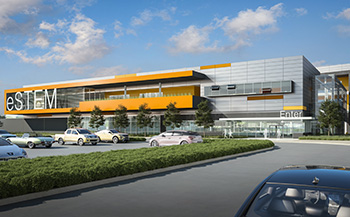Q&A: STEM Environments Support Learning for All Ages
 IRVINE, Calif. — STEM (Science, Technology, Engineering and Mathematics) environments are becoming more and more prevalent on K-12 campuses, with interiors carefully designed to support an innovative curriculum.
IRVINE, Calif. — STEM (Science, Technology, Engineering and Mathematics) environments are becoming more and more prevalent on K-12 campuses, with interiors carefully designed to support an innovative curriculum.
School Construction News spoke with Emily Koch, project designer for Irvine, Calif.-based LPA Inc., and Kate Mraw, associate/design director for LPA Inc., about the key elements they consider when designing STEM environments. Their current projects include STEM spaces for Sequoia Unified School District in Redwood City, Calif., and Corona-Norco Unified School District in Riverside County, Calif., to name a few.
Q: Define what you consider to be a STEM environment.
Koch: A STEM environment supports an integrated, interdisciplinary exploration of STEM subjects applied to project-based learning — where students and teachers are focused on solving real-world problems that break the boundaries of the traditional classroom walls and subject periods.
Mraw: Any environment can become a STEM environment. It is really the teaching and learning activities within the space that begin to create an integrated and interdisciplinary STEM space. It is important to realize that because STEM education is grounded in the real-world application of learning, the space can be much more unique than traditional, lecture-based, learning space.
Q: In what way is a STEM environment different from other learning environments?
Koch: Most importantly, the STEM environment is flexible to support a wide range of activities and technology — researching a topic online, videoconferencing with experts around the world (or even in space!), building a prototype of a solution, or sharing individual and team ideas and outcomes.
Mraw: In a robust STEM environment, the curriculum will reflect realities of students’ lives. So, there will oftentimes be space in the studios or labs that allow for 2D, 3D or digital display of local community issues. Students use that inspiration as their framework for researching and connecting to their problem-based activities. The importance of ‘connecting’ is also reflected in the space with zones that support mentorship, collaboration, brainstorming and design-thinking activities.
Q: What are some of the key elements involved in designing a STEM environment?
Koch: To support these various activities and encourage interdisciplinary collaboration, a STEM environment needs connections to resources — technological as well as tactile. Think makerspace, cardboard, pipe cleaners, sinks for water and washing up messy hands, as well as connections to nature such as outside work areas for fresh air and green-space for restoring creativity.
Mraw: The elements for successful STEM environments are not too dissimilar from those of any Future Ready learning environment. LPA recently completed a research study with the University of San Diego’s Learning Space Design Project, which identified design features that support next generation learning and teaching, highlighting how to unleash student and teacher agency of space. This study focuses on four space concepts that are very relevant in designing STEM environments: Flexible, Collaborative, Transparent and Connected.
Q: Would you say that STEM environments are more beneficial to a specific student age group? If so, which one and why?
Koch: STEM is for all ages and all levels. It’s important to grab the curiosity and wonder that elementary students have, but the middle and high school years are when 21st century skills are set that can impact students’ trajectories beyond school. So, giving these middle and high schoolers real-world understanding of how science and engineering work can set them on the path for success in STEM careers.
Mraw: At an early age, students begin to explore and nourish their creativity, curiosity and sense of wonder. As students mature, these skill sets are valuable tools that help students empathize and innovate solutions to problems that don’t even exist yet. The importance of STEM education cannot be overemphasized. Our role as designers is to support that curiosity by creating environments that are flexible enough to allow for multiple learning modalities; collaborative enough to create opportunities for both informal and formal intersections of ideas; transparent enough to allow learning to happen anywhere so that the student work can be celebrated; and finally, connected enough to the digital community, the learning community, to the outdoors and to the idea of inquiry and discovery.
